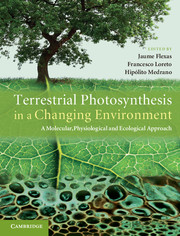 Terrestrial Photosynthesis in a Changing Environment
Terrestrial Photosynthesis in a Changing Environment Book contents
- Frontmatter
- Contents
- List of contributors
- Preface
- Acknowledgements
- List of abbreviations
- 1 Terrestrial photosynthesis in a changing environment
- Part I Photosynthesis
- Part II Measuring photosynthesis
- 9 Gas-exchange analysis: basics and problems
- 10 Optical methods for investigation of leaf photosynthesis
- 11 Stable isotopic compositions related to photosynthesis, photorespiration and respiration
- 12 Mesophyll conductance to CO2
- 13 Biochemical and molecular techniques for the study of photosynthetic processes
- 14 Measuring CO2 exchange at canopy scale: the eddy covariance technique
- 15 Remote sensing of photosynthesis
- Part III Photosynthetic response to single environmental factors
- Part IV Photosynthesis in time
- Part V Photosynthesis in space
- Part VI Photosynthesis in a global context
- References
- Index
9 - Gas-exchange analysis: basics and problems
Published online by Cambridge University Press: 05 March 2013
- Frontmatter
- Contents
- List of contributors
- Preface
- Acknowledgements
- List of abbreviations
- 1 Terrestrial photosynthesis in a changing environment
- Part I Photosynthesis
- Part II Measuring photosynthesis
- 9 Gas-exchange analysis: basics and problems
- 10 Optical methods for investigation of leaf photosynthesis
- 11 Stable isotopic compositions related to photosynthesis, photorespiration and respiration
- 12 Mesophyll conductance to CO2
- 13 Biochemical and molecular techniques for the study of photosynthetic processes
- 14 Measuring CO2 exchange at canopy scale: the eddy covariance technique
- 15 Remote sensing of photosynthesis
- Part III Photosynthetic response to single environmental factors
- Part IV Photosynthesis in time
- Part V Photosynthesis in space
- Part VI Photosynthesis in a global context
- References
- Index
Summary
The Development of Gas-Exchange Systems and their Practical Applications
Gas-exchange systems have come a long way since the technology for real-time measures of gas concentrations in air became available. The method of choice among most plant biologists involves the use of IR gas analysers (IRGAs) integrated into gas-exchange systems to measure concentrations of CO2 taken up by photosynthesis and water released via transpiration (E) over a range of conditions that can be manipulated by the researcher. Typically, gas-exchange systems rely on steady state conditions surrounding photosynthetic tissues, however, unique systems have been developed to measure non-steady state gas exchange for rapid responses (e.g., seconds and faster) to changing conditions (e.g., Laisk and Oja, 1998). Less common, but never-the-less available and quite useful, are methods that rely on oxygen analysers to measure photosynthetic oxygen release. Furthermore, there are methods for determining rates of photosynthesis that rely on Chl-F, reflective indices (e.g., photochemical reflectance index, PRI) and isotopic analysis, each of which are discussed in other chapters. The objective of this chapter is to present and discuss the current methods specific to gas exchange for measuring photosynthesis. This objective includes discussions on the current state of technology, a summary of the equations and theories behind the measurements, potential sources of error and the variables of interest that can be extracted from the most common measurements. Although the focus of this chapter is to provide an ‘entry point’ into the common gas-exchange techniques, it is not intended to provide a complete description of all gas-exchange systems and all physiologically meaningful data that can be collected. Rather, the reader is recommended towards a wide variety of excellent texts that detail many aspects of gas exchange (e.g., Long and Hällgren, 1993; Laisk and Oja, 1998; Long and Bernacchi, 2003).
- Type
- Chapter
- Information
- Terrestrial Photosynthesis in a Changing EnvironmentA Molecular, Physiological, and Ecological Approach, pp. 115 - 130Publisher: Cambridge University PressPrint publication year: 2012
- 1
- Cited by


